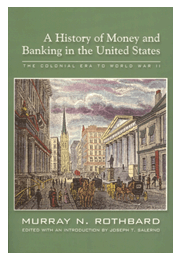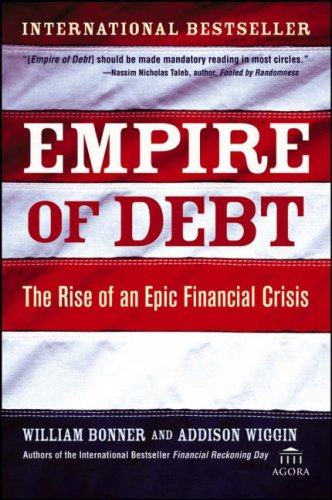
The Case for Gold
By Ron Paul and Lewis Lehrman
The Ludwig von Mises Institute 2007
221 pages. $25.00
Originally published in 1982, The Case for Gold might well have been written in 2010. For the historical and economic realities facing the U.S. at the present time are almost identical to those of the 1980s. Economic prosperity and political freedom are at stake.
In his foreword to the book, Ron Paul says, “This report was written to demonstrate as clearly as possible the choices available to us: political (paper) money or commodity (real) money.”
He begins by discussing the present monetary crisis, which – remember – was the recession of the early 1980s. Paul examines Nixon’s decision to close “the gold window” in 1971. During the ten year period following that decision, retail prices “more than doubled.” Interest rates doubled, while business and personal bankruptcies more than doubled. Real wages went down and unemployment went from 5.5% to 8.9%. Paul’s conclusion is simple: “the Federal Reserve’s discretionary policy of the last several decades has been the cause of our inflation.” In other words, paper money has not only failed. It has failed splendidly.
In chapter two, Paul presents the history of money and banking in the U.S. prior to the 20th Century. He points out that “apart from medieval China, which invented both paper money and printing centuries before the West, the world had never seen government paper money until the colonial government of Massachusetts emitted a fiat paper issue in 1690.” Within a year, the new paper pound depreciated by more than 40%. By 1740, all the colonies – except for Virginia – did the same thing. They started printing paper money. In each instance, the result was identical. “Dramatic inflation, shortage of specie, massive depreciation.” Later, after learning the hard way, the colonies returned to specie, which “occasioned remarkably little dislocation, recession, or price inflation.”
This is precisely the point Paul is trying to make. Going back to hard money is relatively painless. All the previous imbalances are done away with and things return to a healthy normal. As Paul proceeds through his masterful history of money and banking, it becomes obvious that paper money doesn’t work. Fiat currency is inflationary and produces boom bust cycles with devastating regularity.
Chapter three picks up the natural chronology, providing a look at money and banking in the U.S. in the 20th Century. According to Paul, the bankers “had long chafed to cartellize the banking industry still further.” The National Banking System was good, but not good enough. The bankers wanted an even more centralized system. They got their druthers with the Panic of 1907. The Federal Reserve System came into being in 1913. And even though the U.S. was still formally under a gold standard, “the banking systems would now be pyramiding on the U.S. issue of paper money.” Reserve requirements for the banks were chopped in half under the Fed. This meant, as Paul says, “the Federal Reserve was designed from the very beginning to be an instrument for a uniform and coordinated inflation of bank money.”
And that’s exactly what happened. Between 1922 and 1928, bank credit doubled, which caused “speculative excess.” By 1928, the government became alarmed and tightened the money supply, which caused the Depression. Then in 1931, England went off the gold standard. A move that shook the international community. Shortly thereafter, FDR took America off the gold standard.
Paul points out that Bretton Woods, which was supposed to “restore the currency stability of the gold standard,” didn’t, because “it was designed to do so without gold.” In 1971, everything came to a head. Most of Europe let their currencies float, which caused an “unnatural economic imbalance.” Speculators “began betting against the dollar.” The dollar declined rapidly. And on August 15, 1971, Nixon declared “international bankruptcy.” According to Paul, “there were now absolutely no checks on the ability of the United States to inflate.”
In his conclusion to chapter three, Paul bluntly states, “our historical experience illustrates the overwhelmingly superior case for the gold standard as against any form of paper standard.”
‘The case for the gold standard’ is the topic of chapter five. Paul cites many economic reasons why the gold standard makes sense. They include low interest rates, which would accelerate “real economic growth;” increased savings; the revival of long-term financing; reduced federal deficits; full employment; price stability; and “enhanced international trade.”
Paul cites the common objections against a gold standard: there is not enough gold; the principal producers of gold (the Soviet Union and South Africa) would benefit inordinately; the gold standard causes panics and crashes; the gold standard causes inflation; and a gold standard encourages irresponsible speculation. He shoots each objection down in flames, quoting experts and providing hard numbers to do so. His case is persuasive.
In chapter six, Paul outlines the transition to monetary freedom. He gets right to the point in his first sentence. “Our present monetary system is failing.” Then he lists the specific reforms required to implement the transition. Monetary legislation, which includes legal tender laws, a definition of the dollar, new coinage, the removal of central banking, along with guidelines for auditing, inventory control, assaying, and the abrogation of confiscation.
Budget reforms, taxation reforms, and a restructured regulatory system would also be necessary. Paul touches on each one, hitting the high points. He also suggests a constitutional amendment “to reaffirm what the Constitution says.” After that, he outlines the effects of the transition process on six sectors of the economy. He admits “those companies that have been subsidized by the government will suffer most from a movement toward freedom.” After these initial birth pangs, “the transition to a gold system will bring increasing prosperity, real growth, lower unemployment, higher real wages, and greater capital investment.”
You can’t ask for more than that.
The Case for Gold is a tremendous book. Ron Paul’s case is so cohesive and so powerful that it is impossible to refute. Unfortunately, because the book is a combination of history and economics, most people will eschew it. Which is a shame. It should be mandatory reading for all members of Congress and all college students.
![]() On the Read-O-Meter, which ranges from 1 star (deplorable) to 5 stars (triumphant), The Case for Gold receives 5 gold stars.
On the Read-O-Meter, which ranges from 1 star (deplorable) to 5 stars (triumphant), The Case for Gold receives 5 gold stars.



Sounds like a great book! I hope that it does at least as well on the bestseller lists as Ron Paul’s famous Revolution-A Manifesto, and End the Fed.
Every refutation of the Keynesian/ Inflationist fiat money advocacy poison indulged in by the powers-that-be is welcome, and long overdue! Tyranny, like hell, is not easily conquered!
PEACE AND FREEDOM!!
David K. Meller
—Whatever your views of Ron Paul —BEWARE!
This seeming ‘populist’ -much like the bogus ‘America-Firster’ Pat Buchanan -is REALLY very much in fact
pitching cover, blindsides and apologies for our
decades long, disastrous, biz-nihilist sellout and
suck-up to history’s –MOST– awesomely genocidal
regime -bar none! —ACROSS the Pacific. TRUE!
Check out his statements, his stands. Much like
Buchanan, he’s of late taken to tut-tutting the
appalling staus quo in North Asia.
ESP. galing as millions continue to suffer and die
ignored on this, the once again ‘mysteriously
overlooked’ 60th Anniversary of the staggeringly,
loomingly relevant —KOREN WAR…